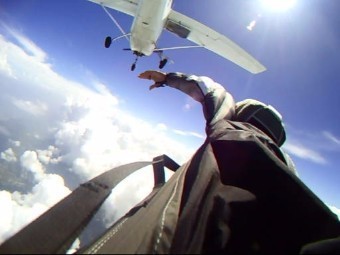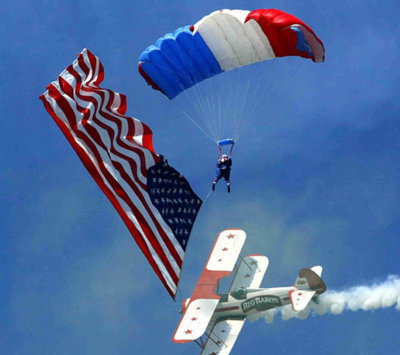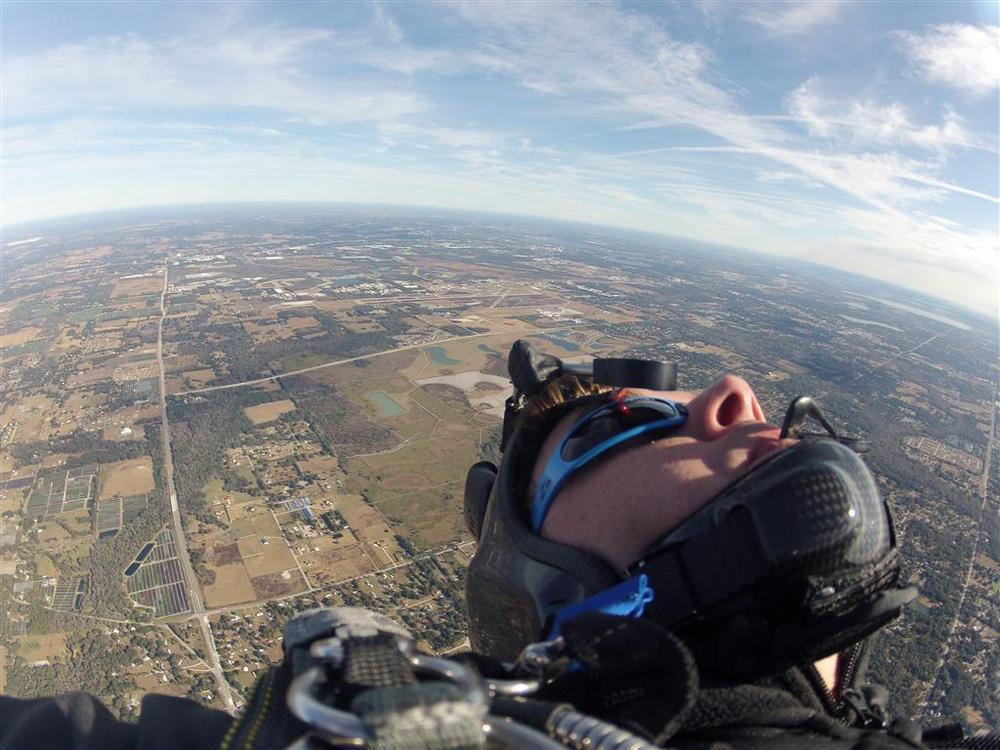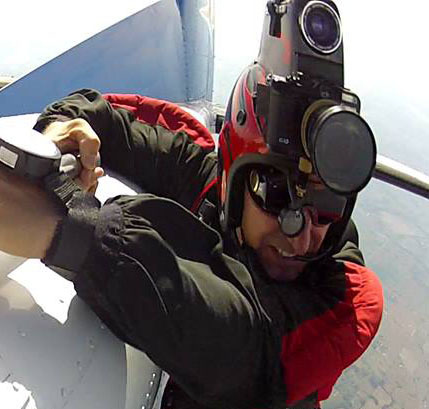Recommended Posts
That's not what I mean, fighting the roll will do no good at all. Relaxing and going with it is far better. What I meant was when you approach the landing, you are probably going to be facing directly forward, and like you say, you are taught to turn slightly sideways, that's what I meant by putting some effort into changing your situation.
OK! Thanks, Jack.
I think botching a PLF in this way is one of the reasons why the word femur gets used as a verb in this sport.
You got my vote!
I think we're all Bozos on this bus.
Falcon5232, SCS8170, SCSA353, POPS9398, DS239
If necessary, PLF like your life depends on it.
With any luck, you can get up, dust yourself off, and go do it again.
PS: When you can do a good slide, as described above, that works well too. It does, IMHO, require a bit more skill than some new jumpers are ready for.
There it is in a nutshell, folks!
Thanks!
I think we're all Bozos on this bus.
Falcon5232, SCS8170, SCSA353, POPS9398, DS239
yeyo 1
The problem with this is if you have too much downward speed you have given up some of the shock absorbtion the legs provide. If things go wrong, there is not much between you and a serious back injury. I'm not saying things will go wrong with you, but a new jumper coming down hard will do better with a PLF, using the legs to translate downward into forward motion. Forward motion can be challanging, but it beats that sudden stop.
Of course as Andy said, botched PLF's don't count.
If necessary, PLF like your life depends on it.
With any luck, you can get up, dust yourself off, and go do it again.
PS: When you can do a good slide, as described above, that works well too. It does, IMHO, require a bit more skill than some new jumpers are ready for.
Yep, agree on everything, the key part for me is "if necessary"...
All landings are different, well not ALL but you know what Im saying.
If Im going faster than I can run, Im sliding.
If I got too much 'downward speed', Ill flare and tip toe
From my jumps I just remember one time where I HAD to PLF...Went too agressive on an outlanding when I should've take it slow (leason learned), miss-judged approach a little and found a little tree at the end of my line...had to use whatever lift I had left on the canopy to hop over the tree and dropped on the other side bout 8 feet like there was no canopy. Did a ninja PLF/roll and ended on my feet like 10' short of some barbwire fence (its on video)
So, sliding for me is just another tool, just gotta know when to use it.
DS #419.5
Skyper 0
edit: for the "slide" put your legs too high and you risc pretty intense rubbing of your ass and your leg streps. put your legs too low you risc ending up in the face plant position. and even one hole or rock on your path can make those two scenarios above even worse.
velvetjo 0
That's what I was looking for - firsthand experience with problems using the modified slide. It's certainly not ideal for rough terrain.
I was pretty skeptical when I initially saw it taught in a FJC, but after seeing it for 5+ years I'm convinced it has a place in every jumper's toolkit. Kinda like brake turns - not something you'll use every time, but something you want to know how to do in case you need it.
Lance
billvon 3,073
I see a lot of people do this, and in my experience causes the most injuries of any kind of seated landing. When you have one knee bent under you, your knee is very weak (held together only by tendons and ligaments) and the cartilage of your femoral condyles are "leading" (i.e. they're what will take any impact if you slide into something.)
So if everything goes well it works.
If your trailing foot catches something, your cruciate ligaments will take all the force of your stopping. ACL and MCL ligament ruptures are likely.
If you run into anything with your knee, the articular cartilage (the bearing surface) will take the impact. If you damage that surface you can't repair it, and at best you'll have early arthritis.
Compare that to sliding with your feet forward and knees bent. If you hit anything in that position, the force is transmitted through the large bearing surfaces of your knees and the muscles of your thigh. Since that's how your knee is intended to work, you can take a lot of impact without damage.
Having done thousands of PLFs, I tend to agree with Pops. A properly executed PLF automatically slides in on a fast landing. I remember thinking this when that article came out, too.
With the importance of landing correctly, I must admit that I am surprised that modern training has done away with practicing PLF's to the extent that it has. Our training was carried out over more than 1 day and involved falling off of bales of hay for about 8 hours. Admittedly they were rounds and so for many people it was critical to avoid injury.
We used a platform and practiced at 4 and 8 feet...a hundred leaps @ 8 feet teaches proper positioning pretty quick!
Another thing to also consider is what you are wearing~ tevas, those cute toe shoes and big lug waffle stomper boots aren't the best thing going for either a slide or a proper PLF.
I ALWAYS wear leather high-top basketball shoes with rather smooth soles. The high tops help protect the ankles and the smooth soles won't grip the turf 'too' much...A guy I do demos with use to wear his combat boots all the time, no wind day landing on AstroTurf blew out an ACL because the boot just stopped and he kept going, I heard the pop 50' up under canopy!
Also another thing to consider is your helmet, I had to PLF an undersized reserve while wearing 3 cameras on my head...NOT recommended!!
Being an old guy with lots of steel in my lower spine I've gone with a slide whenever I have more forward speed than run-out-able. I tuck my right foot up under my butt, put my left out front with some tension to 'guide' the slide and lean back letting the tucked shoe and the container take most of the hit...so far so good.
BUT, if I'm coming down faster than forward, I sure am glad I did all the 'proper' PLF training back in the day!
To Bill;
>>When you have one knee bent under you, your knee is very weak (held together only by tendons and ligaments) and the cartilage of your femoral condyles are "leading" (i.e. they're what will take any impact if you slide into something.)
I agree to an extent, If you incurr a tucked foot slide that will pop a knee in many cases (mine for sure) the damage to the lower spine would have been worse.
I've had both knee and back injuries...I'd much rather limp than not walk.
~ If you choke a Smurf, what color does it turn? ~
MakeItHappen 15
It starts with both feet touching the ground at the same time.
The lower leg is slightly bent. The sole of the lower shoe is about even with the ankle of the upper leg.
You still press your feet and knees together.
In baseball, you'd use the 'breakaway slide' for when your lower foot touches the bag.
Your lower leg bends more and then is used to transfer your momentum to stand up as your lower leg hits the base, so you can continue on if the opposing team throws the ball away. You can even do this with breakaway bases because the force on the bag is not enough to break it away.
.
Make It Happen
Parachute History
DiveMaker
~ If you choke a Smurf, what color does it turn? ~
Inspired 0
We used a platform and practiced at 4 and 8 feet...a hundred leaps @ 8 feet teaches proper positioning pretty quick!
If I want to practice high speed PLFs, can I just jump from the tailgate of a moving pickup?
Top of a moving train would work MUCH better..please get video!
~ If you choke a Smurf, what color does it turn? ~
Don't know where some of you learned how to do a baseball slide.
You are not going to believe this but that's OK.
Bobby Richardson
His sister lived two doors down from us and he would visit her every off-season. I learned more about baseball and life from him than anyone else.
Sorry, but what you describe is nothing near best sliding technique.
I won't mention Hal Jeffcoat. His sons played youth baseball with us and Mr. Jeffcoat taught us all sorts of things about baseball. Sliding, as per Bobby, too.
But...Thanks 'Twardo!
PETE ROSE was my hero!!!!!
It was a badge of honor leaving after every game with the dirtiest arms, face, chest and thighs of anyone else on the team.
I think we're all Bozos on this bus.
Falcon5232, SCS8170, SCSA353, POPS9398, DS239
BrianM 1
On a high speed PLF, you get your feet and knees together and bend your knees, with your knees angled in some direction or the other. This protects your knees and ankles. When you hit, you let yourself collapse, so that your feet, sides of calves and the sides of your thighs hit. Then you stop and let yourself slide feet-first through the landing area.
Stopping a PLF at that point will have you sliding head first, not feet first.
billvon 3,073
Not if your feet are in front of you. It takes a little practice.
>Stopping a PLF at that point will have you sliding head first, not feet first.
Not if your feet are in front of you. It takes a little practice.
Could you explain HOW to get your feet back in front of you?
I've done one or two PLF's, and I cannot imagine how you would end up with your feet in front of you while still sliding.
DPH -7, TDS 578, Muff 5153, SCR 14890
I'm an asshole, and I approve this message
..... or, here's a novel approach, students should be jumping lightly loaded, docile canopies on low wind days. If you cannot handle whatever the day will throw at you, you shouldn’t be jumping. I know $h!t happens, but, you can control the degree to which it occurs.
If you're around this sport long enough, you'll get a chance to practice PLF's. Don't miss any opportunities to practice these techniques on the ground... just in case.![]()
"Son, only two things fall from the sky."
If you're around this sport long enough, you'll get a chance to practice PLF's.
Here's my take:
One of these days you're going to need to do a good PLF.
Wouldn't it be a good idea to have some PLF experience before you actually need it?
Hence, I tell my students to do PLF landings right from the git-go. Stand-up will come later.
Other I's tell them to stand up landings from jump 1. Stand-up is a goal, yes. Trying to PLF in a dire situation without having ever done one quite often results in a mess.
I think we're all Bozos on this bus.
Falcon5232, SCS8170, SCSA353, POPS9398, DS239
BIGUN 1,421
I choose to PLF when I can, but learned to slide effectively when hauling meat to protect the student. One thing to remember on a high speed landing and PLF's is... When PLF's were devised, there were no reserve parachutes on your back so rolling across the shoulder blades was no problem. With a high speed landing these days, one could injure their back rolling over the reserve.
billvon 3,073
Ever seen a student do the odd thing where their legs come up as their arms come down during the flare? About 10% of them do it for some reason, and they land on their butts.
Now take that, but instead of legs straight in front, put your feet and knees together, bend your legs a little, and twist to the right or the left (i.e. the same way you'd set up for a forward PLF.) Keep your legs up. Let the side of your feet touch first, then let your calves and the side of your thigh hit. At that point you should have your legs in front of you, and you'll be sliding on your side.
>Could you explain HOW to get your feet back in front of you?
Ever seen a student do the odd thing where their legs come up as their arms come down during the flare? About 10% of them do it for some reason, and they land on their butts.
Now take that, but instead of legs straight in front, put your feet and knees together, bend your legs a little, and twist to the right or the left (i.e. the same way you'd set up for a forward PLF.) Keep your legs up. Let the side of your feet touch first, then let your calves and the side of your thigh hit. At that point you should have your legs in front of you, and you'll be sliding on your side.
The only part about that that sounds like a PLF is feet and knees together, bent and rotated. Still sounds like a baseball slide landing, with the added risk of now hitting the ground too hard with your spine already contorted instead of generally straight.
I know you have way more jumps and time in the sport than I will for a very long time, but I cannot see how this would be a safer alternative for a high speed landing.
DPH -7, TDS 578, Muff 5153, SCR 14890
I'm an asshole, and I approve this message
BrianM 1
>Stopping a PLF at that point will have you sliding head first, not feet first.
Not if your feet are in front of you. It takes a little practice.
... in which case it is a plain old slide, not a PLF.
Muffie 0
Ever seen a student do the odd thing where their legs come up as their arms come down during the flare? About 10% of them do it for some reason, and they land on their butts.
Trying not to derail the thread, but this is what I did when I started and I figured out that it was because when I did practice flares up high this was how I moved my body to get full flare. So, I slid in a number of my first landings on my butt as a result. No pain until about jump 30 when I wasn't current and did this too high and came down hard. After that when I was doing my practice flares I really focused on keeping my legs down.
I've also (unintentionally) done the one foot tucked under landing. Problem I had with it is that I ended up with a lot of dirt in my shoe and some scratches along the top of my ankle between my sock and jumpsuit that took about a week to heal.




.thumb.jpg.4bb795e2eaf21b8b300039a5e1ec7f92.jpg)






Share this post
Link to post
Share on other sites